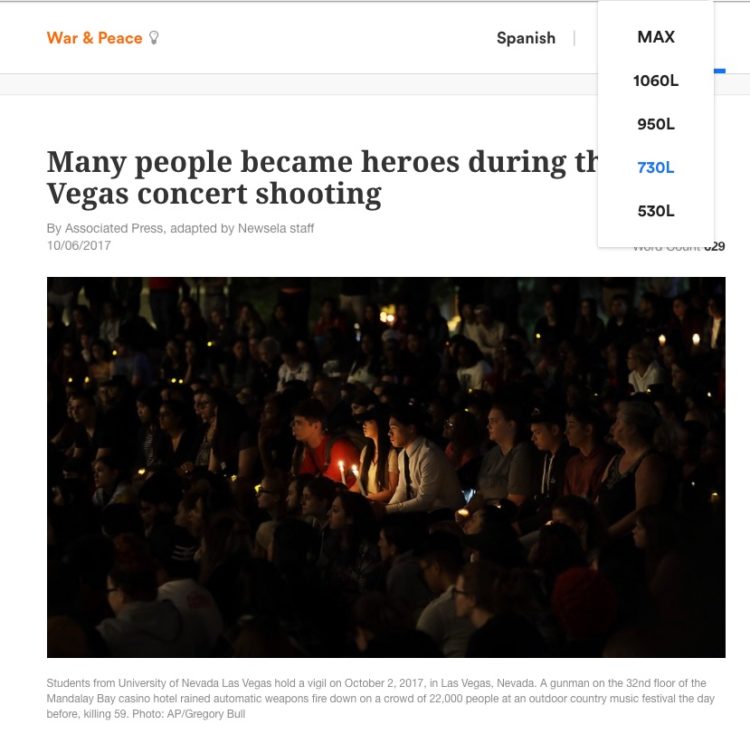 When things get tough, the tough use tools.
When things get tough, the tough use tools.
Whether you’re actively trying to embed current events in your curriculum or helping your students respond to the headlines, here are five useful tools to help you wrangle news in the classroom.
1. Newsela
We’ve talked about Newsela before, and it remains an incredible resource for making current events accessible to readers at all levels.
Newsela curates high-interest news stories at multiple reading levels. This allows students to access nonfiction text on current events in ways that are differentiated to meet them where they are. Using the paid service, teachers can assign texts and track student progress. Teachers and students can also annotate texts, marking them up as they make meaning. Newsela features “text sets” on a given topic. Teachers can also create and share their own text sets — a nice way to offer students choice.
Of course, student-created text sets would make this an even more powerful use of technology. It would allow students to curate content about a topic of interest and share their work with their classmates and teacher.
At Frederick H. Tuttle Middle School, in South Burlington, educator Christie Nold used Newsela with NPR and BBC resources to teach her students how to spot fake news. The students created infographics in Canva to share what they learned with peers.
2. Listenwise
Listenwise provides NPR podcasts through a Current Events portal and a lesson plan portal for Science, ELA, and Social Studies classes.
The podcasts are short, current, and include thoughtful questions for reflection or discussion. Like audiobooks, podcasts bridge content for students who struggle with reading while engaging them in complex content. But Listenwise isn’t just for struggling readers. All kinds of learners will benefit from these stories. Listenwise also provides graphic organizers and vocabulary guides to support students as they learn.
3. Allsides
Allsides provides stories from all perspectives on the same news event.
It seeks to diminish polarization by introducing readers to a range of stories and making biases explicit. Allsides is piloting a free program for schools that includes tools to engage students in the news while fostering civil dialogue and critical thinking.

4. Vermont Online Library (VOL)
Check in with your Librarian!
School libraries have access to a variety of resources, many of them related to current events. Collaborate with your librarian to use your schools’ databases and subscriptions, including the Vermont Online Library (VOL), to connect students to a wide variety of news. VOL provides all Vermont schools with access to a wide variety of databases. These include full-text access to a variety of current newspapers through Infotrac Newsstand and contrasting perspectives on current social issues via Opposing Viewpoints in Context. Your school librarian can provide you with a password and help you design instruction that puts students in the driver’s seat as they navigate these resources (and the ones above!) and dig into the news.
5. Crowdsourced resource lists
Tap into the wisdom of twitter.
Crowdsourced lists about tragic events and difficult content can be invaluable. Using social media, teachers collaborate to share resources and ideas about teaching tough topics. After Michael Brown was killed by a police officer in Ferguson, noted historian of African American studies Dr. Marcia Chatelain created #FergusonSyllabus, a twitter-based movement encouraging educators, academics, and engaged citizens to curate resources for schools around the tragedy. Three years later, educators continue to use these resources to teach about race and civil rights.
https://twitter.com/bsktcase/status/897862868611121153
More recently, the hashtag #CharlottesvilleCurriculum is a response to the racial violence in Charlottesville, VA. The New York Times reached out to teachers. It wanted to know how they handle the news in the classroom and created a companion list of resources.
How #Teachers Bring #Charlottesville to their Ss, via @NYTimes w/ @facinghistory. #CharlottesvilleCurriculum https://t.co/CXqvp9nytW
— Facing History CHI (@FacingCHI) September 29, 2017
I wonder what a student-sourced curriculum in response to a local event might look like. What resources might our students curate to learn more about Burlington’s homeless problem, the opioid crisis, or the lynching of an 8-year-old boy in New Hampshire? The resources above would make a great starting point for their research.
How are your students exploring current events?



